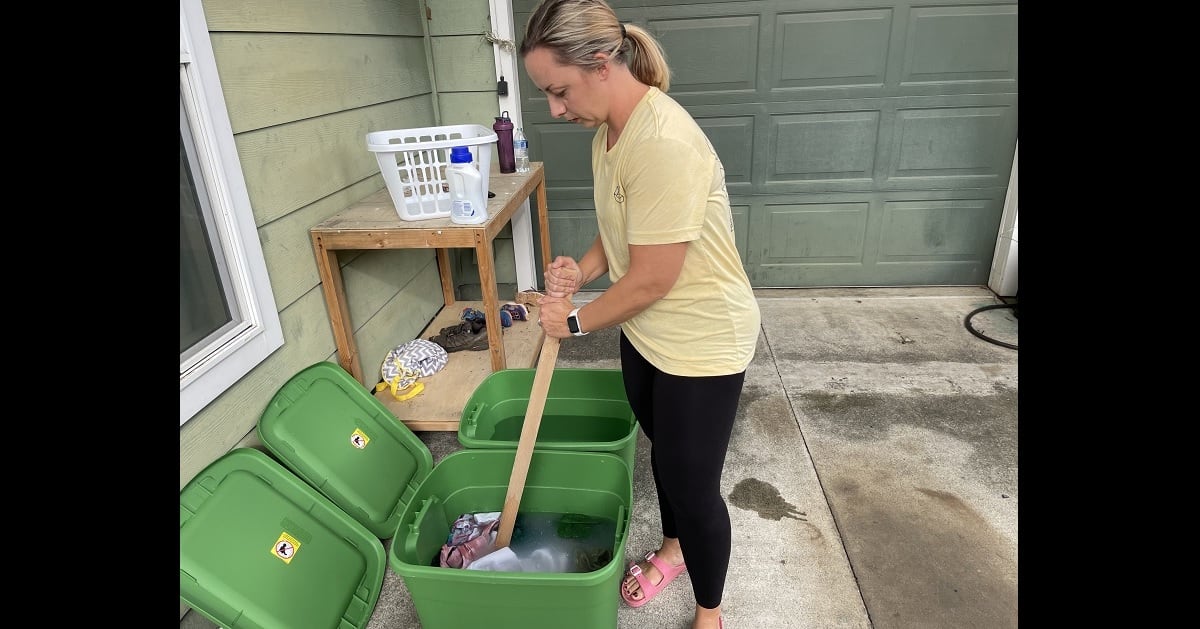A Hawaii congresswoman is pressing for answers in the wake of new complaints about residents’ drinking water — a fuel sheen, strong odors, and a chemical taste — nearly two years after the Navy finished its massive effort to flush out and clean up 19,000 gallons of fuel that had leaked into their water supply at Joint Base Pearl Harbor-Hickam.
“Where is the possible contamination even coming from? The public deserves to know,” said Rep. Jill Tokuda, D-Hawaii, during a hearing for the House Armed Services Committee’s readiness panel on Wednesday. “Our service members and their families deserve to know that their water is safe and clean to drink. The Navy has a public health responsibility to urgently get to the bottom of this and make sure people know that the water that they drink, that they give to their families, is safe.”
Tokuda said the Hawaii Department of Health has received about 50 complaints over tap water and air quality from people using the Navy water system. In addition, water samples that were tested in the fall had trace amounts of diesel.
“While the chemical signatures don’t correspond with the jet fuel that was stored at [Red Hill Bulk Fuel Storage Facility], where we had 19,000 gallons emptied into our drinking water system, impacting service members, their families and civilians, it is disturbing that we’re talking about chemical traces in our drinking water, “she said.
“We’re concerned, too,” said Meredith Berger, assistant secretary of the Navy for installations, energy and environment. “Any time that we hear there is a report of something that is wrong, especially when it comes to water, we are taking action and responding.”
The Navy has put together a team of scientists and communications experts to research the problem, and to share the information with residents, said Berger, testifying before the panel. Navy officials have visited the homes or locations identified and gathered information from those individuals, provided bottled water and have tested the water, Berger said. “Significantly, we have seen that every indication is below the 266 [parts per billion of Total Petroleum Hydrocarbons]” threshold for safe drinking water that the Hawaii Department of Health has set, she said.
However, she added, “there is something wrong, and we need to see what is causing people to report that they are having an impact.”
According to a Jan. 8 Navy press release, the results of tests of water samples ranged from nothing detected to 144 parts per billion for Total Petroleum Hydrocarbons (TPH). An analysis of each sample that showed Total Petroleum Hydrocarbons showed no signs of JP-5 jet fuel, officials said.
But Tokuda questioned the effects of even lower levels of TPH.
“We do not know what exposure to lower levels of TPH in our drinking water … what that could mean to both service members and their families, and to civilians that are being exposed through these water system leakages and whatnot,” she said.
“But at the end of the day,” continued Tokuda, “if there’s a sheen on your water, and a smell coming from it, would you pick up that glass and drink it?”
Meanwhile, a recent lawsuit filed alleging the Navy was negligent in its actions surrounding the fuel leaks in 2021 also alleges that there are ongoing problems with the water, citing reports from the Environmental Protection Agency in 2022 where traces of petroleum were found in three of four homes tested. In October 2023, the EPA investigators observed an oily sheen in the water and ongoing health symptoms, such as rashes, and called for inspections and sampling of water heaters and plumbing.
The lawsuit was filed Feb. 5 in federal court in Hawaii, with 2,212 military family members and civilians. Two other lawsuits were filed earlier with a total of 301 plaintiffs.
The lawsuit also cites data from the Navy’s continued testing of the water that showed continued detections of TPH in the Navy water system. According to Kristina Baehr, one of the attorneys representing families, more than 50% of the samples taken — 1,453 out of 3,045 in 2023 — detected TPH.
RELATED

All told, more than 93,000 individuals were affected when their water was contaminated in 2021 by the jet fuel spill at the Red Hill Bulk Fuel Storage Facility. There were 9,715 households in 19 different communities on the Navy water system of Joint Base Pearl Harbor-Hickam who were affected. They include residents of two Army communities and Air Force communities in the Hickam side. Some Hawaiian civilians were also affected, living in homes supplied by Navy water.
On Nov. 28, 2021, military families reported smelling fuel odors and seeing an oily film in their tap water. But some had reported mysterious abdominal pain, vomiting, memory loss, skin rashes, eye irritation, and teeth and gum issues even before the signs of fuel appeared. At first, Navy officials told residents it was okay to drink the water.
Since Dec. 3, 2021, the Hawaii Navy water system has been sourced only by the Waiawa Shaft. Water from the Waiawa Shaft, located 6.2 miles from Red Hill, is monitored to make sure it meets Hawaii Department of Health and Environmental Protection Agency standards for safe drinking water, according to the Navy.
The latest lawsuit highlights the experiences of eight families out of the 2,212 plaintiffs. Of those, 1,197 are filing medical negligence claims. The case is named for the Hughes family. Jaclyn Hughes gave birth to their third child in mid-November of 2021, and her Navy husband returned to Hawaii from Japan, where he was stationed, to be with the family.
But around Thanksgiving, their water had an oily sheen and smelled of gasoline. Their newborn son was covered in red rashes, and Jaclyn’s throat was sore and burned. Their middle child, 4 years old at the time, once with “a vivacious spirit, turned into a whirl of confusion and rage,” according to the lawsuit.
By February 2022, the child had become self-injurious and violent, clawing at her skin and pulling her hair out, according to the lawsuit. Costs piled up for the family, including costs of care and testing from out-of-network doctors. Plans to move to Japan to join her Navy husband became impossible, as the child’s new diagnoses, including level one autism spectrum disorder, made the family ineligible for orders outside the continental U.S. The husband was granted compassionate reassignment to return to Hawaii; and the family was reassigned for humanitarian reasons to California in 2023.
Now, the child has slowly stabilized, with support from an extensive care team, according to the lawsuit. “Despite this, the trauma experienced and fear of what the future holds has created suffering the family may never be able to escape,” the lawsuit alleges.
The Hughes family’s lawsuit, and two others allege that while the Navy has taken responsibility for the fuel leaks, they haven’t taken responsibility for failure to warn residents about the fuel release.
Meanwhile, the Navy is in the process of draining and shutting down the Red Hill Bulk Fuel Storage Facility. By November, the Navy had removed more than 104 million gallons of fuel, or 99.5% of the fuel previously stored there.
They have since removed about 25,000 gallons of residual fuel as the next step. The facility, which has been providing fuel to the military in the Pacific since World War II, had the capacity to hold 250 million gallons of fuel, but was at less than half the capacity.
Karen has covered military families, quality of life and consumer issues for Military Times for more than 30 years, and is co-author of a chapter on media coverage of military families in the book "A Battle Plan for Supporting Military Families." She previously worked for newspapers in Guam, Norfolk, Jacksonville, Fla., and Athens, Ga.





